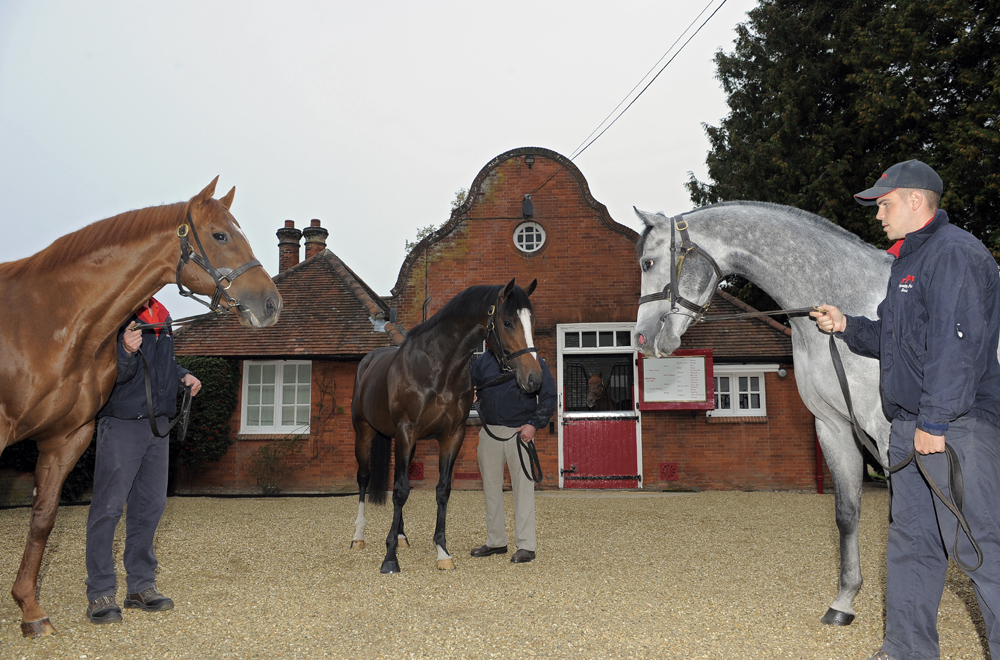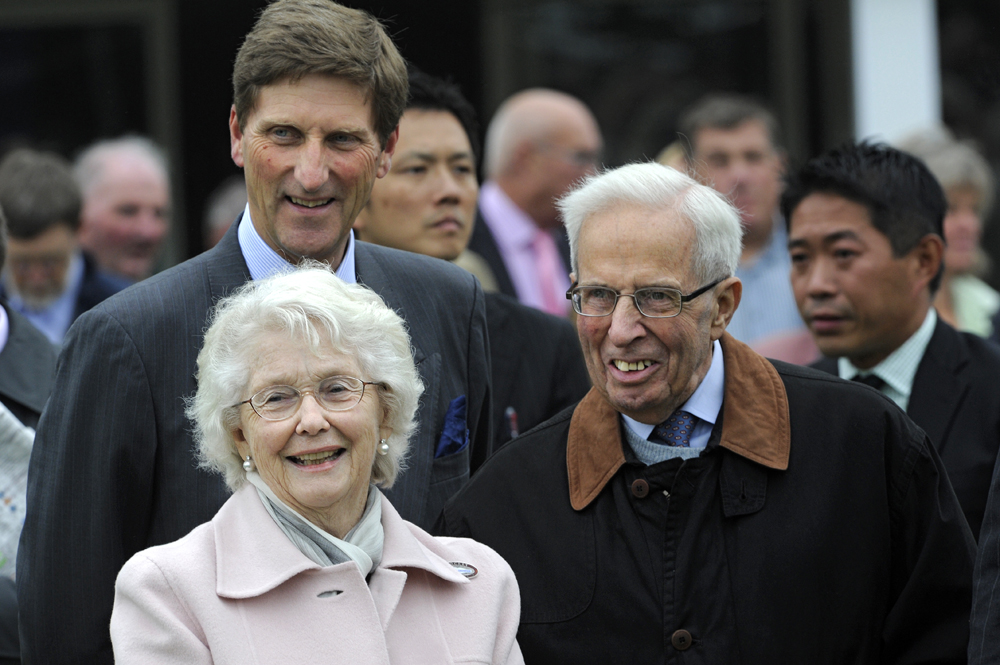It can’t have been ten years ago, surely? That was Patricia Thompson’s reaction to the prompt that Cheveley Park Stud’s famous silks featured on the front cover of Owner & Breeder’s inaugural issue in September 2004.
Time flies when you’re having fun, and it has been a memorable decade for the Newmarket nursery. On the racing front it has campaigned nine individual Group 1-winning fillies in addition to Virtual, winner of the 2009 Lockinge Stakes. And its tribe of stallions is flourishing, with Pivotal continuing to lead the way with more than 100 individual stakes winners, 24 of them in Group 1 company.
Those are the headline acts, but there is plenty of depth to the story. Dutch Art, a son of the stud’s homebred stallion, Medicean, propelled himself to the forefront of breeders’ thinking after Slade Power’s sizzling Diamond Jubilee-July Cup double. Moreover, Dutch Art’s son, the Group 1-winning sprinter Garswood, joins the roster for 2015.
Add in the likes of proven speed source Kyllachy, together with young wannabes Mayson and Dark Angel’s son Lethal Force, and the portents for the next decade are encouraging. In truth, it is as much as Cheveley Park Stud deserves. A deal of good fortune is required to scale such heights but the stud has stood so firmly behind its own horses it is entitled to believe it has made its own luck.
There have also been disappointments, as is preordained in this business, but the stud stands out as a bastion of the British breeding scene every bit as prominently as its red, white and blue silks stand out on the racetrack.

Falmouth Stakes winner Integral
The latter detail is highlighted by Cheveley Park Stud’s long-serving Managing Director, Chris Richardson. “It makes us proud when commentators refer to ‘those well-known Cheveley Park colours’ as they call a race,” he says. “It shows we have achieved something.”
Patricia Thompson who, with her husband David, has owned the stud for 39 years, believes continuity of purpose is paramount.
This is a challenging and seductive business and, above all, it is fun
“I don’t like new ideas if the old ones work well,” she says. “Our path is well established, although this is an ever-changing industry, a fascinating industry, and we are involved in every facet.”
One constant since the Thompsons’ purchase of the property, then a 270-acre concern in receivership, has been Cheveley Park Stud’s association with fast horses. Back in 1975 they walked through the gates to find a couple of forlorn broodmares and Forlorn River, a 13-year-old stallion who’d pulled off the July Cup-Nunthorpe double.
Two years later and Music Boy, winner of the Gimcrack Stakes for the Thompsons, was installed as their first new stallion. They were advised against it but put their faith in Music Boy, who went on to become leading first-season sire with a crop of just 17 foals. Subsequently a strong influence for speed, Music Boy is commemorated in bronze outside the stud’s office.
This predilection for fast horses remains a Cheveley Park Stud bedrock. “We have a very strong client base of breeders who want that particular strain of stallion,” Richardson says.
“We have tried other types here, horses like Saddlers’ Hall, Benny The Dip and Groom Dancer, but they are much harder to sell. Over the years we have worked out that sprinter types work best for us. Other horses just don’t seem to fit the Cheveley Park Stud perspective.”
The theme extends to the Richard Fahey-trained Garswood, who truly epitomises the brand. The four-year-old was bred by Cheveley Park Stud and sold as a foal for 19,000gns before the stud bought back into him at the end of his two-year-old season. As a grandson of Medicean, he represents the third generation of his male line at Cheveley Park Stud. And since Garswood is out of a Kyllachy mare, three of his four grandparents are scions of the stud.
Garswood, who is Cheveley Park Stud’s fourth new stallion in the last three years, came from the same source as Mayson. Both were originally raced from Richard Fahey’s prolific stable by David Armstrong. Where they differ is that Mayson is a son of Invincible Spirit, which introduces a new male line into the stud – even if he is out of a Pivotal mare.
“It is important for us to stand stallions from different lines,” Patricia Thompson says. “It’s a bit like a shop window: you don’t fill it with the same dresses if you want to attract a broad range of clients.”
Armstrong has been a regular supporter of the stud’s stallions, which made the decision to buy into his racehorses a natural fit. “We have enjoyed a long and successful relationship,” Richardson reflects. “David has used our stallions religiously so we were pleased to be able to reciprocate.”
Indeed, the success of their joint racing ventures tempted David Thompson to join Armstrong in placing a handful of yearling purchases with Fahey. Although the partnership was a one-off venture, it serves to highlight the Thompsons’ insatiable enthusiasm after four decades of involvement.

Dutch Art, Intello and Lethal Force in the stallion yard
While the stud is run on a business footing, the Thompsons still enjoy digressing into fun-loving aspects of the sport. In Patricia’s case this received expression when her husband gifted her Party Politics 48 eight hours before the horse won the 1992 Grand National.
One aspect of Cheveley Park Stud’s policy to have evolved is that it no longer buys yearlings in the US. Like many British-based breeders, it believes the quality of stallions now available in Europe has negated the need, although the stud has reason to be grateful for its early penchant for American blood.
The likes of Exclusive Order, Gay Gallanta, Polish Romance and Russian Rhythm, from whom so many of its contemporary mares descend, have proved worth their weight in gold. Integral, Cheveley Park Stud’s banner racehorse this year, is a great-granddaughter of Exclusive Order, while Garswood is a great-grandson of Polish Romance.
And if buying American distaff blood has run its course, the stud’s policy of selling some of its homebred yearlings has crystallised over the last decade. All the yearling colts are offered for sale except those with a less-than-flawless upbringing. Conversely, all the homebred fillies are allocated to one of 13 trainers. The stud has around 100 horses in training each season.
Although the policy of selling all the colts is not new, it still raises certain questions. “We are slightly tarnished with a brush in that some people believe we keep the best colts at home, which we don’t,” Richardson says. “If there’s an issue that could affect a sale, there is no point in offering them. Otherwise we show them all.”
The advantages of selling its colts are twofold. The first is to limit the number of horses the stud puts into training each year to around 100; the second is to raise capital for the purchase of future stallions. In the latter respect the stud has found that buying shares in a horse in training, rather than buying well-bred yearling colts, is the better way.
“We have tried buying yearling colts,” Richardson says. “We have also tried a combination of racing our better colts together with a handful of yearling purchases, while selling the other homebred colts, but it just confused everybody.”
The dilemma resolved itself when Cheveley Park Stud concentrated on using funds from the sale of yearling colts to buy into specifically-targeted horses in training. “It is more cost-effective,” Richardson says. “We take an interest with a view to taking a bigger stake in the horse later on. It is highly competitive.”
Mayson, Lethal Force and Garswood were all recruited in this way. So too was Polar Falcon, who was bought from Michel Zerolo at the end of his three-year-old season in 1990 and subsequently sired both Pivotal and Integral’s granddam, Exclusive, before his death at the age of 14. Little wonder that Patricia Thompson prefers proven formulae over the new-fangled.
On a broader note, Richardson says the business of standing stallions has become far more competitive in the last decade. “There are infinitely more opportunities for breeders who can choose from a wide pool of stallions in Britain and Ireland,” he says.
“It has even encouraged international breeders to come to breed their mares here,” he continues. “It was all America 30 years ago; now it’s all in Europe thanks principally to the Maktoum family, Coolmore Stud and now the Al Thanis. We are in a very fortunate position.”
Richardson also feels the last decade has highlighted how robustly the breeding industry coped in the face of a recession that brought other industries to their knees. Cheveley Park Stud felt the icy blast without having to confront a blizzard.
“We had to be very aware of the financial difficulties people faced when setting our stallion fees,” Richardson says. “Overall, however, we are left with the impression a lot of breeders and owners were perhaps happier – or considered it a good investment – to be involved in bloodstock rather than leaving their money in the bank.”
As for the next ten years, Richardson would like a reprise. “We always strive to do better,” he says. “At the moment we are fifth on the owners’ table, which I think is very respectable considering the four outfits above us, but we will keep our heads down and keep trying.”
He adds: “The team here is a great strength. We all treat Cheveley Park Stud as if it was our own, but we know full well that Mr and Mrs Thompson are the owners, the driving force. We want to do as well as we can for them and I think that’s true of our 13 trainers. There’s a great sense of pride in being involved.”
Independent and traditional
For Patricia Thompson, the recipe for success over the last ten years is uncomplicated. “We have very much stuck to how we run things in our own independent and traditional way,” she says.
“We have had lots of support from breeders on the stallion side, so we have them to thank. And on the racing side, you have to be patient. We had three quiet seasons after Hooray won the [2010] Cheveley Park Stakes but there’s no point in flapping. I’m quite calm, temperamentally, and these things are cyclical. If you are lucky, fortune will smile on you again.”
Thompson is smiling again after Integral posted her second Group 1 triumph of the season in the Sun Chariot Stakes. And her enthusiasm for the homebred four-year-old filly is such that Integral is scheduled to race again next season.
“Why not?” her owner asks. “She had only really spent one and a half seasons in training. What I would really like to see next year is Integral and her two half-sisters all running on the same day.” In which case Provenance, a three-year-old filly by Galileo, and Entity, a two-year-old filly by Shamardal, had better raise their game.

Patricia and David Thompson with Chris Richardson (back left)
Even after 40 years of involvement her enthusiasm remains that of a racing debutante. But the traffic is rarely one way: Thompson has also had to contend with the death this year of two of the stud’s prized racemares, the Group 1 winners Chorist and Russian Rhythm, who were 15 and 14.
The breeding business teaches those involved to guard against expectation but Thompson believes it is part of the game’s magnetic appeal. Sentiment is also part of the mix: every year she must wave goodbye to the homebred yearling colts bound for the sales, although not all will find buyers.
The stud’s policy dictates that all blemish-free colts must be offered, yet Thompson leaves the impression she welcomes some of them back with open arms. “If people don’t want them we are quite happy to race them ourselves,” she says.
She was quietly hoping such a fate would befall Integral’s yearling half-brother by Medicean, who was recently offered in Book 1 at Tattersalls. But alas, the colt caught Sheikh Hamdan’s eye and, at 400,000gns, he had to go.
The most attractive statement about any farm is the willingness of industry leaders to embrace it. That was evident when the Wertheimer brothers sent Intello to open his stallion innings at Cheveley Park Stud. The son of Galileo, winner of the 2013 Prix du Jockey-Club, completed the first of two scheduled seasons earlier this year.
“Getting Intello was a tremendous feather in our cap,” Thompson says. “It was a real compliment, especially to Chris [Richardson], who sells the stud so well. We took it as a good signal from the international bloodstock industry.”
As for the future, Thompson’s ambitions reflect the times.
“Just to still be here in the face of increasing competition,” she says. “It has become a tough business; it is even tougher for us because we don’t shuttle our stallions. But we are very happy.
“I hope we can continue to do things well for our clients,” she continues. “Some of the staff have been here for 30 years. It has been very fulfilling for us, everything is solid.
“It has been a good decade for us. This is a challenging and seductive business and, above all, it is fun. You enjoy it more as you get older because you know more about it. It has been very satisfying – and it hasn’t ended yet.”



